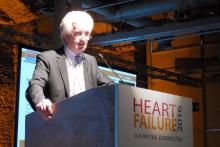FLORENCE, ITALY – A novel intravenous prodrug that results in formation of nitroxyl once inside the body showed several potentially beneficial hemodynamic effects during a single, 6-hour infusion in a controlled proof-of-concept study with 46 patients hospitalized with advanced heart failure with reduced ejection fraction.
While receiving the drug, patients showed “statistically significant and clinically meaningful” reductions in pulmonary capillary wedge pressure and in pulmonary artery diastolic pressure, two of the studies three primary endpoints, Dr. Veselin Mitrovic said at a meeting held by the Heart Failure Association of the ESC.
For the study’s third primary endpoint, a change in cardiac index, treatment with the drug led to increased cardiac output using noninvasive measures, especially at the highest tested dose, as well as in all of the subset of treated patients in whom cardiac index was measured by thermodilution.
On the safety side, the drug appeared safe and well tolerated at all four tested doses, while causing no episodes of symptomatic hypotension and no increase in heart rate. Transient, asymptomatic reductions in blood pressure were similar in the treated and control patients.
“This is a very interesting and exciting drug that went in the right direction,” summed up Dr. Mitrovic, professor of cardiology at Goethe University in Frankfurt, Germany, and head of the department of cardiovascular research at the Kerckhoff Clinic in Bad Nauheim, Germany.
“This is the first demonstration of safety and preliminary efficacy in patients with advanced heart failure,” he said in an interview. “We had a very good clinical signal in a relatively small study. We now need a larger study.”
The drug “improved myocardial function in several ways: inotropy, lusitropy, and unloading. It also causes arterial vasodilation and increased stroke volume,” Dr. Mitrovic said. “Other drugs with a positive inotropic effect increase myocardial oxygen consumption; but with this drug, we see a neutral effect on mixed venous oxygen saturation. It balances myocardial oxygen consumption by its effect on unloading and reduced vascular resistance. This is a big advantage.”
Each molecule of nitroxyl is made from single atoms of hydrogen, nitrogen, and oxygen, and its physiologic action is distinct from nitric monoxide. Nitroxyl improves calcium efficiency and recycling without producing intracellular calcium overload, and its effects are not mediated by cyclic AMP or cyclic GMP.
The dose-ranging study enrolled 34 patients with New York Heart Association class III heart failure and 11 with class IV. All patients had to have a left ventricular ejection fraction of 40% or less, and their actual ejection fractions averaged about 25%.
When measured after 2, 4, and 6 hours of infusion, pulmonary capillary wedge pressure (PCWP) fell by an average of about 5 mm Hg, compared with baseline, among patients who received the three highest-dose infusions of the nitroxyl prodrug, known as CXL-1427, and by an average of about 3 mm Hg in those who received the lowest dose.
That effect had disappeared when PCWP was remeasured 2 hours after the end of the 6-hour infusion, and the 11 patients randomized to placebo showed no change at any time point in PCWP. The average declines in PCWP in each of the four dose groups were statistically significant changes, compared with the control patients.
All the drug-treated patients showed an average drop in pulmonary artery systolic pressure of about 5 mm Hg, compared with baseline, and about 3-4 mm Hg in pulmonary artery diastolic pressure. The patients who received the highest dose of CXL-1427 had an average drop in their right artery pressure of about 4 mm Hg. All of those decreases were statistically significant, compared with the lack of any measurable changes in the control patients.
Total peripheral resistance also showed statistically significant declines relative to baseline in all the treated patients when these decreases were compared with the controls.
CXL-1427 was initially developed by Cardioxyl Pharmaceuticals. Bristol-Myers Squibb acquired the company in late 2015. The study was sponsored by Cardioxyl. Dr. Mitrovic has been a consultant to Bayer, Cardiorentis, and Novartis.
On Twitter @mitchelzoler


